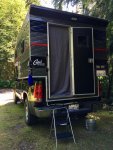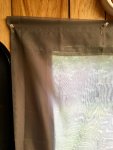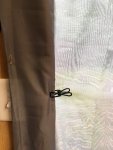Umnak
Adventurer
The following is cross-posted with our In Progress Adventures Thread: https://www.expeditionportal.com/fo...-america-plus-a-few-more.150556/#post-1959205
We’ve had the Capri Retreat for almost 2 months, and have spent about half that time with it on the road in a variety of weather and places. With that, it seems that an initial review is in order.

Background: Our previous road trip vehicle was a 2006 Sportsmobile Sprinter. We sold the Sprinter after 3 years on the road as we were moving into a permanent residence and wanted something that could take its place and serve as a second vehicle. The idea of a truck camper came from the need for a rig that we could use anywhere we wanted to go, and especially those places we felt couldn’t be handled by the Sprinter. The 4x4 Sprinters that had come to market during our road trip were very expensive and as long as our TN1. 4x4 domestic vans were hard to find and with the whole #vanlife thing having emerged during the past few years, also too expensive.
I drooled over a few Defender 110s with a pop-up but the reality of living on the wrong side of the world from the parts store and mechanics held sway over that decision.
We moved away from soft-sided pop-ups because of the cold and wet conditions in which we will be using the camper for a part of the year. As luck would have it, the truck camper we had hoped to purchase — Pastime — decided to close it doors the week we wanted to place an order. I recalled reading some good things about Capri and decided to give them a call and see what we could build. I’m so happy it turned out that way.
Capri makes unique truck campers and they make them well.
Overview: We like the truck camper, a lot. But it’s not just the camper, it’s also the truck. The 4x4 GMC Sierra with the 6 speed Alison Transmission and haul/tow package is a work horse. And a comfortable one at that. The camper sits nicely on the truck. At 7’ it’s longer than the bed, but doesn’t stick out over the bumper. The truck’s length is 18.5’ which makes two tracks and winding roads simple to maneuver. The camper’s width is perfect for hauling, as it doesn’t require the truck to add extended side-view mirrors. The height of the camper and the truck is just about what we were used to in the Sprinter at 9’6”.
It’s comfortable inside without a table, though I’m not sure it would be with one always in place. There is enough room for me to prepare a meal and have two people sitting on the comfortable cushions provided by Capri. The always made bed is a huge advantage over our Sprinter, whose bed had to be stolen each night from the settee.
Storage is more than adequate for two minimalists like us. We had more than enough space for food and gear on our recent 2 week trip.

Build: The company provides a great deal of options and is very easy to work with. Communication during the build was exceptional, with daily progress emails and photographs. Our Retreat has no shower, water heater, stove top or table. Capri was willing to install our ARB 50 quart fridge and, as it being the first one they had ever done, figured out a good place to put it and keep it viable for easy removal. Options we chose included a 10 gal water tank, house battery, fantastic fan, a few extra windows, and catalytic heater. We also bought a Dometic portable toilet from Capri who has a great storage spot for it when not in use.
Capri offers a number of interior finishes. I chose pecan as it seemed the lightest in color and it paired well with the wooden cabinet doors and walls. The exterior of any Capri can be customized by the owner. Our’s is silver with black stripes and a red accent line. Looks nice on the black truck.
Fit and finish are good overall. Everything is neat and trim. There were a few exposed screw points in storage areas and one of the cabinet doors would scrape the ceiling when the camper roof heated up from the sun ( which seems to expand the roof and ceiling). The overall feel is comfortable and authentic. There are no plastic fittings or molding. The cushions and mattress are of good quality. The Retreat feels solid and weathers rough roads well. It’s also pretty cool looking and has the same puppy appeal as our Sportsmobile did in the first couple of years on the road.
I like the turnbuckle system that is inside the truck bed and camper. We have had no problems with the camper moving on the bed and the lack of external ties and turnbuckles gives a clean look to the rig.
If my math is correct the camper weighs a bit over 1300 lbs, which puts us a little over gvwr, but with LT tires, sway bar and Timbrens it doesn’t impact performance or driving. We are getting 18mpg without the camper and 14mpg with it installed.

Counters and cabinets:
The sink is deep and holds everything you need for a sink while traveling. There is sufficient room for our Snow Peak Baja stove — with the propane canister sitting securely in the sink — as well as counter top for food prep. That portion of the counter is hinged to allow access to the ARB fridge, something Capri worked out and executed well. We use the cabinets above the stove for light food storage. A basket below the sink holds drink and food cans.
The large cabinet that would have housed the Capri fridge was built with three shelves, two of which are used for utensils, a pot, pan and stove. Toiletries and other small items take the top shelf. These could hold more if needed, but we hope that doesn’t happen.
A long cabinet with three doors on the starboard side of the camper holds our clothing and some electronic gear. Again, we could put a lot more in these.
Capri has two very simple convenience storage areas as part of their standard build. A small shelf under the large cabinet, which would normally house the Capri fridge, holds the stuff in your pockets during the night. A phone shelf with accompanying 12v and usb ports is a great addition, and increases the sound and especial the base from our iPhones. I do wish the phone rack was placed a bit higher and toward the rear to reduce the chances of banging one’s head if sleeping on that side of the camper. Maybe I’ll move it.

We’ve had the Capri Retreat for almost 2 months, and have spent about half that time with it on the road in a variety of weather and places. With that, it seems that an initial review is in order.
Background: Our previous road trip vehicle was a 2006 Sportsmobile Sprinter. We sold the Sprinter after 3 years on the road as we were moving into a permanent residence and wanted something that could take its place and serve as a second vehicle. The idea of a truck camper came from the need for a rig that we could use anywhere we wanted to go, and especially those places we felt couldn’t be handled by the Sprinter. The 4x4 Sprinters that had come to market during our road trip were very expensive and as long as our TN1. 4x4 domestic vans were hard to find and with the whole #vanlife thing having emerged during the past few years, also too expensive.
I drooled over a few Defender 110s with a pop-up but the reality of living on the wrong side of the world from the parts store and mechanics held sway over that decision.
We moved away from soft-sided pop-ups because of the cold and wet conditions in which we will be using the camper for a part of the year. As luck would have it, the truck camper we had hoped to purchase — Pastime — decided to close it doors the week we wanted to place an order. I recalled reading some good things about Capri and decided to give them a call and see what we could build. I’m so happy it turned out that way.
Capri makes unique truck campers and they make them well.
Overview: We like the truck camper, a lot. But it’s not just the camper, it’s also the truck. The 4x4 GMC Sierra with the 6 speed Alison Transmission and haul/tow package is a work horse. And a comfortable one at that. The camper sits nicely on the truck. At 7’ it’s longer than the bed, but doesn’t stick out over the bumper. The truck’s length is 18.5’ which makes two tracks and winding roads simple to maneuver. The camper’s width is perfect for hauling, as it doesn’t require the truck to add extended side-view mirrors. The height of the camper and the truck is just about what we were used to in the Sprinter at 9’6”.
It’s comfortable inside without a table, though I’m not sure it would be with one always in place. There is enough room for me to prepare a meal and have two people sitting on the comfortable cushions provided by Capri. The always made bed is a huge advantage over our Sprinter, whose bed had to be stolen each night from the settee.
Storage is more than adequate for two minimalists like us. We had more than enough space for food and gear on our recent 2 week trip.
Build: The company provides a great deal of options and is very easy to work with. Communication during the build was exceptional, with daily progress emails and photographs. Our Retreat has no shower, water heater, stove top or table. Capri was willing to install our ARB 50 quart fridge and, as it being the first one they had ever done, figured out a good place to put it and keep it viable for easy removal. Options we chose included a 10 gal water tank, house battery, fantastic fan, a few extra windows, and catalytic heater. We also bought a Dometic portable toilet from Capri who has a great storage spot for it when not in use.
Capri offers a number of interior finishes. I chose pecan as it seemed the lightest in color and it paired well with the wooden cabinet doors and walls. The exterior of any Capri can be customized by the owner. Our’s is silver with black stripes and a red accent line. Looks nice on the black truck.
Fit and finish are good overall. Everything is neat and trim. There were a few exposed screw points in storage areas and one of the cabinet doors would scrape the ceiling when the camper roof heated up from the sun ( which seems to expand the roof and ceiling). The overall feel is comfortable and authentic. There are no plastic fittings or molding. The cushions and mattress are of good quality. The Retreat feels solid and weathers rough roads well. It’s also pretty cool looking and has the same puppy appeal as our Sportsmobile did in the first couple of years on the road.
I like the turnbuckle system that is inside the truck bed and camper. We have had no problems with the camper moving on the bed and the lack of external ties and turnbuckles gives a clean look to the rig.
If my math is correct the camper weighs a bit over 1300 lbs, which puts us a little over gvwr, but with LT tires, sway bar and Timbrens it doesn’t impact performance or driving. We are getting 18mpg without the camper and 14mpg with it installed.
Counters and cabinets:
The sink is deep and holds everything you need for a sink while traveling. There is sufficient room for our Snow Peak Baja stove — with the propane canister sitting securely in the sink — as well as counter top for food prep. That portion of the counter is hinged to allow access to the ARB fridge, something Capri worked out and executed well. We use the cabinets above the stove for light food storage. A basket below the sink holds drink and food cans.
The large cabinet that would have housed the Capri fridge was built with three shelves, two of which are used for utensils, a pot, pan and stove. Toiletries and other small items take the top shelf. These could hold more if needed, but we hope that doesn’t happen.
A long cabinet with three doors on the starboard side of the camper holds our clothing and some electronic gear. Again, we could put a lot more in these.
Capri has two very simple convenience storage areas as part of their standard build. A small shelf under the large cabinet, which would normally house the Capri fridge, holds the stuff in your pockets during the night. A phone shelf with accompanying 12v and usb ports is a great addition, and increases the sound and especial the base from our iPhones. I do wish the phone rack was placed a bit higher and toward the rear to reduce the chances of banging one’s head if sleeping on that side of the camper. Maybe I’ll move it.




